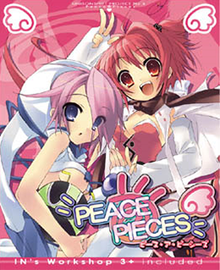This article has multiple issues. Please help improve it or discuss these issues on the talk page. (Learn how and when to remove these messages)
|
 | |
| Developer(s) | Unisonshift |
|---|---|
| Publisher(s) | Unisonshift |
| Platform(s) | Windows |
| Release |
|
| Genre(s) | Eroge, Visual novel |
| Mode(s) | Single-player |
Peace@Pieces (ピースアピーシーズ, Pīsu a Pīshīzu) is a Japanese adult visual novel developed by Unisonshift and was released on December 23, 2004, for Windows. The game was described by the development team as a "sweet school romance comedy with lewd moe situation adventure" (学園恋愛甘甘コメディ萌シチュエーションえっちあどべんちゃー, Gakuen ren'ai ama ama komedi moe shichuēshon ecchi adobenchā). The gameplay in Peace@Pieces follows a linear plot line, which offers pre-determined scenarios and courses of interaction, and focuses on the appeal of the main female characters.
Development
Peace@Pieces was the tenth project developed by Unisonshift, and is developed as an adult game much like previous titles such as Innocent Eye's. Planning for the game was headed by @Pieces. Art direction and character designs were provided by Noizi Ito, known for her work on Shakugan no Shana, the Haruhi Suzumiya franchise, and the later Nanatsuiro Drops. The scenario was provided solely by Tamaki Ichikawa. Music in the game was solely composed by Ryō Mizutsuki, known for her later contributions on BaseSon's Koihime Musō, and Key Sounds Label's Piano no Mori.
Release history
Peace@Pieces was first introduced to the public on December 23, 2004, as a DVD-ROM playable on only a Microsoft Windows PC, and was subsequently followed by a fan disc, titled One More@Pieces, released on August 9, 2005. It was later followed by a second release, titled Peace@Pieces + One More@Pieces Special Memorial Edition, released on November 22, 2007, containing the game itself and the fan disc.
References
- ^ "Top page at Peace@Pieces' official website" (in Japanese). Unisonshift. Retrieved 2008-08-08.
- "A list of Ryō Mizutsuki's visual novel contributions" (in Japanese). Erogamescape. Archived from the original on 2009-02-18. Retrieved 2008-08-09.
- "Key Sounds Label's discography" (in Japanese). Key Sounds Label. Archived from the original on 2007-04-10. Retrieved 2007-03-15.
- "Top page at One More@Pieces official website" (in Japanese). Unisonshift. Retrieved 2008-08-09.
External links
- Official Peace@Pieces visual novel website (in Japanese)
- Peace@Pieces at The Visual Novel Database
- Peace@Pieces Fandisc One More@Pieces at The Visual Novel Database
This visual novel–related article is a stub. You can help Misplaced Pages by expanding it. |